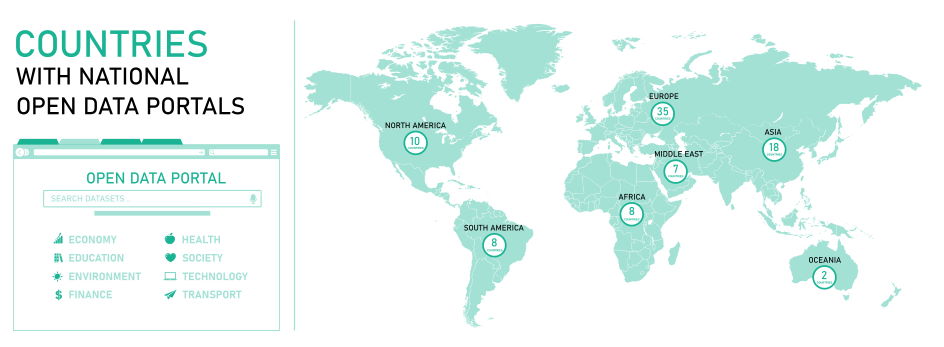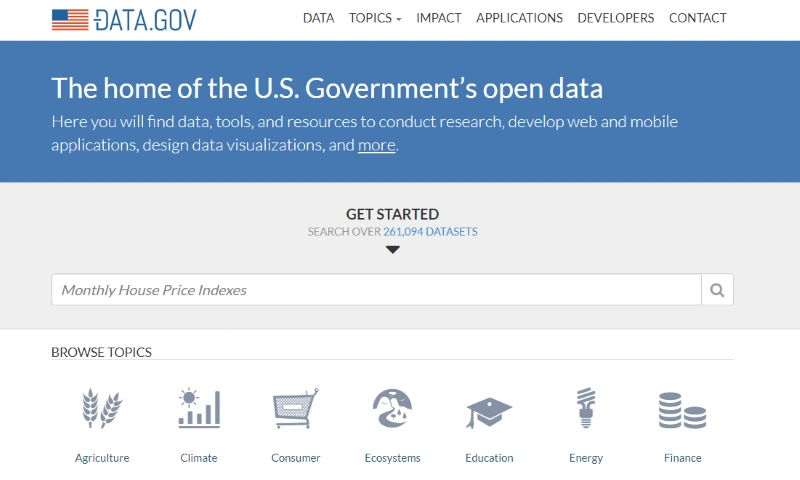In 2019, about 88 out of 252 countries deployed and launched national open data portals for public data sharing, publishing close to 1,190,474 open datasets altogether. 48 of these countries are from countries with high-income GNI (Gross National Income) per capita, while 22 are from upper-middle income countries, 14 from lower-middle income countries and 4 from low-income GNI per capita countries, based on Worldbank's income classification based on GNI per capita.

Country-level Open Data Portals
DIGITALIZATION INITIATIVES
In the late 2000s, most developed countries started "digitalization" initiatives to actively use digital technologies and digital data to improve government and citizenry services. Over the years, governments began to accumulate massive troves of digital data - static data from digitized sources, spatial data from digital maps, user/usage data from service apps and real-time data from IoT (Internet-of-Things) sensor infrastructure.
As the velocity and volume of accumulated data grew exponentially, governments realized that the only way to fully harness such data is to release such data as open data to public in a systematic, structured and strategic manner. This led to governments centralizing open data sharing efforts behind a common, national open data portal.
SHARING OF OPEN DATA
The intended wisdom behind the sharing of open data is that the innovation capabilities of the government are inherently limited and as more open data becomes accessible, private ecosystems, companies and individuals can make good use of such open data to deliver agile and sustainable services that deliver more benefits to citizens and thus, enhancing the overall innovation level and digital economy of the country.
Applications of open data for citizens and governments.
NATIONAL OPEN DATA PORTALS
A natural outcome of a country's open government and open data initiative is the creation of a national open data portal. National open data portals aggregate all data of a country in a single point of access, instead of hosting disparate data at different government agencies. Thus, with national open data portals, it becomes highly productive for service developers to discover, search, access and use open data.

List of countries with national open data portals, ranked by number of datasets published ( FULL DATASET)
Altogether, countries with national open data portals have published a total of 1,190,474 open datasets. The United States' national open data portal (https://data.gov) alone shared 261,090 open datasets, the largest number of datasets published by a national open data portal. This is followed by the national open data portals of Czech Republic (134,479 datasets), Australia (85,234 dataset) and Canada (83,279 datasets).

Number of datasets published, by region (FULL SOURCE)
Regionally, Europe has published the highest number of open datasets at 481,137, driven in part by European Union's open data strategy that seeks to leverage on easy and free access to data to promote innovation and data economy in Europe. North America published the second highest number of datasets at 387,677, followed by Asia at 183,510.
World-map distribution of countries with country-level open data portals (FULL SOURCE)
THE ECONOMICS
Developed countries in North America and Europe have embarked on digitalization efforts much earlier than the rest of the world, with developing nations in Asia catching up rapidly as a result of high economic growth rates. Strong economic support allows a country to make investments beyond basic survival/subsistence issues, such as food, water, health and peace, to strategic issues such as the digital infrastructure to start data digitization and accumulation.

Number of countries with national open data portals, grouped by GNI-per-capita classification (data source)
It is only when a government has accumulated enough critical mass of shareable data that a national open data portal becomes practical and meaningful to spur strong private-sector innovation. Thus, in general, there is strong correlation and causality between the available of national data open portals and the economic strength of a country.
48 of these countries with national open data portals are from countries with high-income GNI (Gross National Income) per capita, while 22 are from upper-middle income countries, 14 from lower-middle income countries and 4 from low-income GNI per capita countries, based on Worldbank's income classification based on GNI per capita.
NOTEWORTHY NATIONAL PORTALS
United States (data.gov) - 261,090 datasets. The United States's national open data portal has published the largest number of datasets in the world, sharing out a whopping collection of 261,090 datasets or about 20% of the world's publicly accessible country-level open datasets.

Taiwan (data.gov.tw) - 43,727 datasets. Taiwan was consistently ranked as the top country in the Global Open Data Indexes for 2015-2016. Within Asia, Taiwan's open data portal, launched since 2013, has the highest number of datasets at 43,727.The portal is the product of the open data initiative under Taiwan's Digital Government Program.

France (data.gouv.fr) - 39,439 datasets. The French national open data portal was developed by Etalab (https://www.etalab.gouv.fr/), a government agency under the authority of the Prime Minister that was commissioned to coordinate the public data policy
National Open Data Portal of France
CONCLUSION
As countries continue to invest in open data initiatives and national as well as city-level open data portals, they begin to see returns in innovative apps and services being introduced that can benefit resident businesses as well as citizens. As the move to open data continually yield tangible innovation and improvement to citizen wellbeing, government productivity, and multiplier benefits, we should see more countries accelerating their digitalization programs and uncovering suitable data within their national "firewalled" or "air-gapped" data troves to share in a national open data portal. We will continue to update next year.
DATA SOURCES
You may also be interested in this article Smart Cities - The Rise Of Aggregated Open Data Portals, No More Silo to understand how smart cities handle open data.


